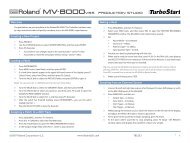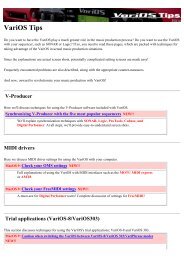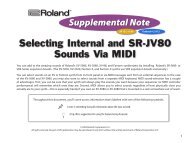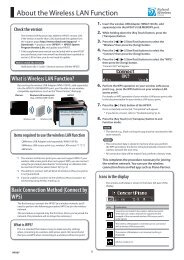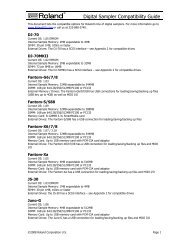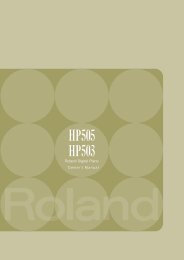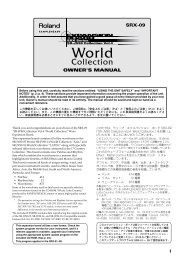You also want an ePaper? Increase the reach of your titles
YUMPU automatically turns print PDFs into web optimized ePapers that Google loves.
Chapter 4. Memory Settings (Utility/Card Mode)<br />
Block (Source Block)<br />
Specify the source of the data to be transmitted.<br />
USER: Data from user memory will be transmitted.<br />
PR-A–C, E: Preset A/B/C/E data will be transmitted.<br />
GM: GM data will be transmitted.<br />
XP-A–E: Data from an Wave Expansion Board will be<br />
transmitted.<br />
* XP-D, E can be selected only if the corresponding Wave<br />
Expansion Board is installed.<br />
CARD: Performance/Patch/Rhythm Set/System data<br />
stored on memory card will be transmitted.<br />
fig.4-29.e<br />
Memory Card-Related<br />
Settings (CARD)<br />
XP-30 can use an optional memory card (S2M-5 (2MByte) or<br />
S4M-5 (4MByte)).<br />
Use this card when you wish to save data for which there is<br />
no more space in the internal USER group, or so that the data<br />
you created can be used on another XP-30.<br />
Memory card must be formatted before they can be used.<br />
* When you select “1: CARD” in the UTIL 2 group, the following<br />
CARD display will appear. Select the function you wish to<br />
execute.<br />
fig.4-31<br />
File number<br />
File name<br />
Destination<br />
Set the transmission destination to USER.<br />
* If the Type parameter has been set to PERFORM, PATCH, or<br />
RHYTHM, specify the first number of the transmission<br />
destination.<br />
Before Using a Memory Card<br />
* The power of the XP-30 must be turned off before inserting or<br />
removing a memory card. If a memory card is inserted when the<br />
power is turned on, the data in the memory card may be<br />
destroyed, or the memory card may become unusable.<br />
Preventing User Memory<br />
Writing Operation (PROTECT)<br />
This function prevents user memory from being rewritten to<br />
ensure Patch, Performance or Rhythm Set data will not<br />
accidentally be lost.<br />
fig.4-30<br />
Internal (Internal Write Protect)<br />
The Internal write Protect setting prevents the Write<br />
operation from rewriting user memory. When this setting is<br />
ON, the data cannot be rewritten. When this is OFF, the data<br />
can be rewritten. When the XP-30’s power is turned on, this<br />
setting is always turned ON, so you will need to turn it OFF<br />
before rewriting user memory settings. It is also possible to<br />
turn this setting OFF as part of the Write procedure.<br />
* Be sure to insert the memory card all the way into the slot.<br />
* Do not touch the contacts of the memory card, or allow them to<br />
become soiled.<br />
* Never remove the memory card or turn off the power while an<br />
operation (formatting, or data read/write) is being performed on<br />
the memory card. Doing so will destroy the data in the memory<br />
card and/or render the memory card unusable.<br />
* If you affix the write protect label to the write protect area of the<br />
memory card, it will be impossible to format the card or write<br />
data to it. If you wish to format the card or write data to it, do so<br />
without the label affixed. For details on the write protect label,<br />
refer to the instruction included with your memory card.<br />
If you attempt to format the card or write data to it when the<br />
write protect label is affixed, the following message will<br />
appear.<br />
fig.4-32<br />
Chapter 4<br />
Exclusive (Exclusive Protect)<br />
The Exclusive Protect setting prevents System Exclusive<br />
messages received from an external MIDI device from<br />
rewriting user memory settings. When this setting is ON, the<br />
data cannot be rewritten. When this is OFF, the data can be<br />
rewritten by an incoming exclusive message, even if the<br />
Internal Write Protect setting is ON.<br />
121





